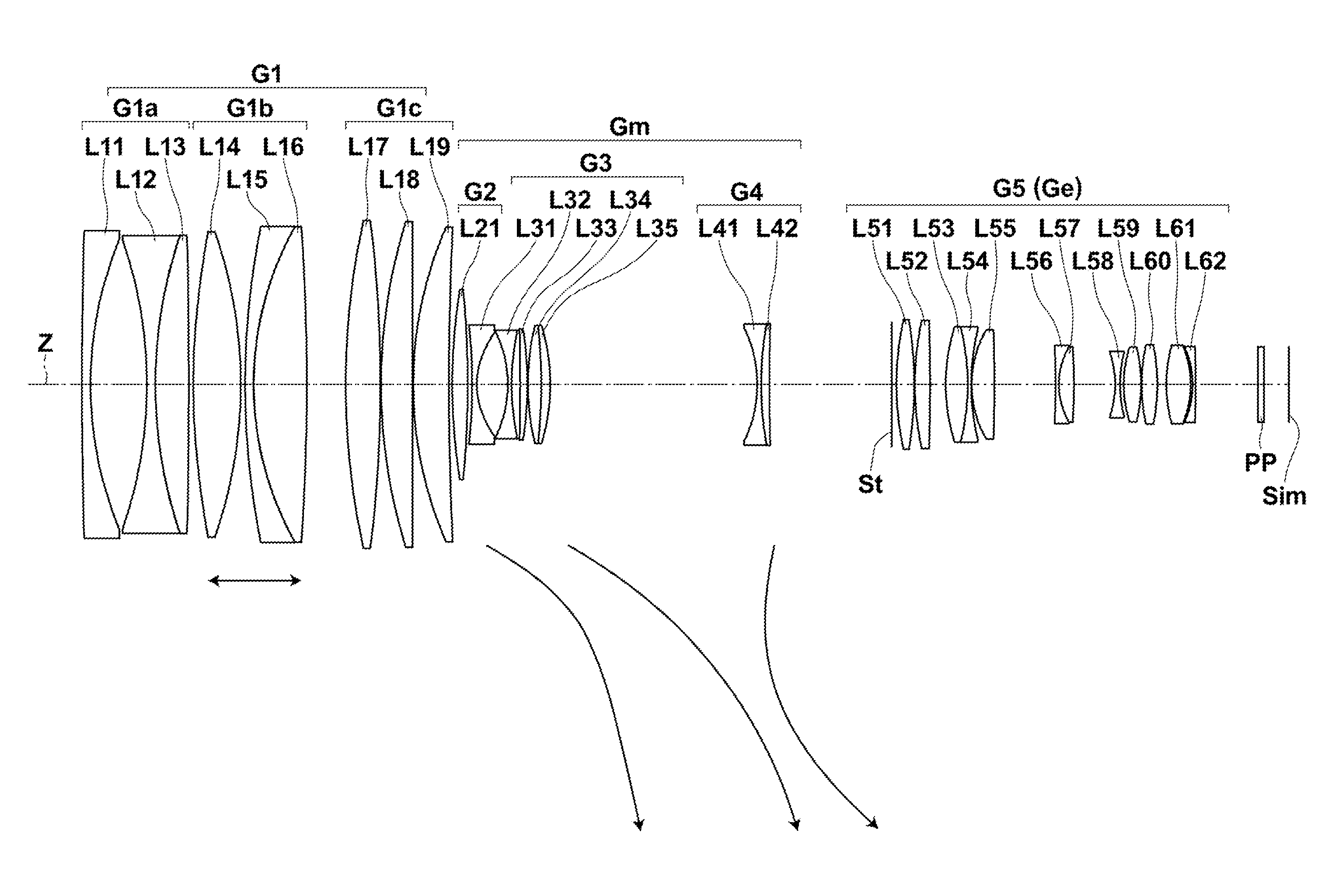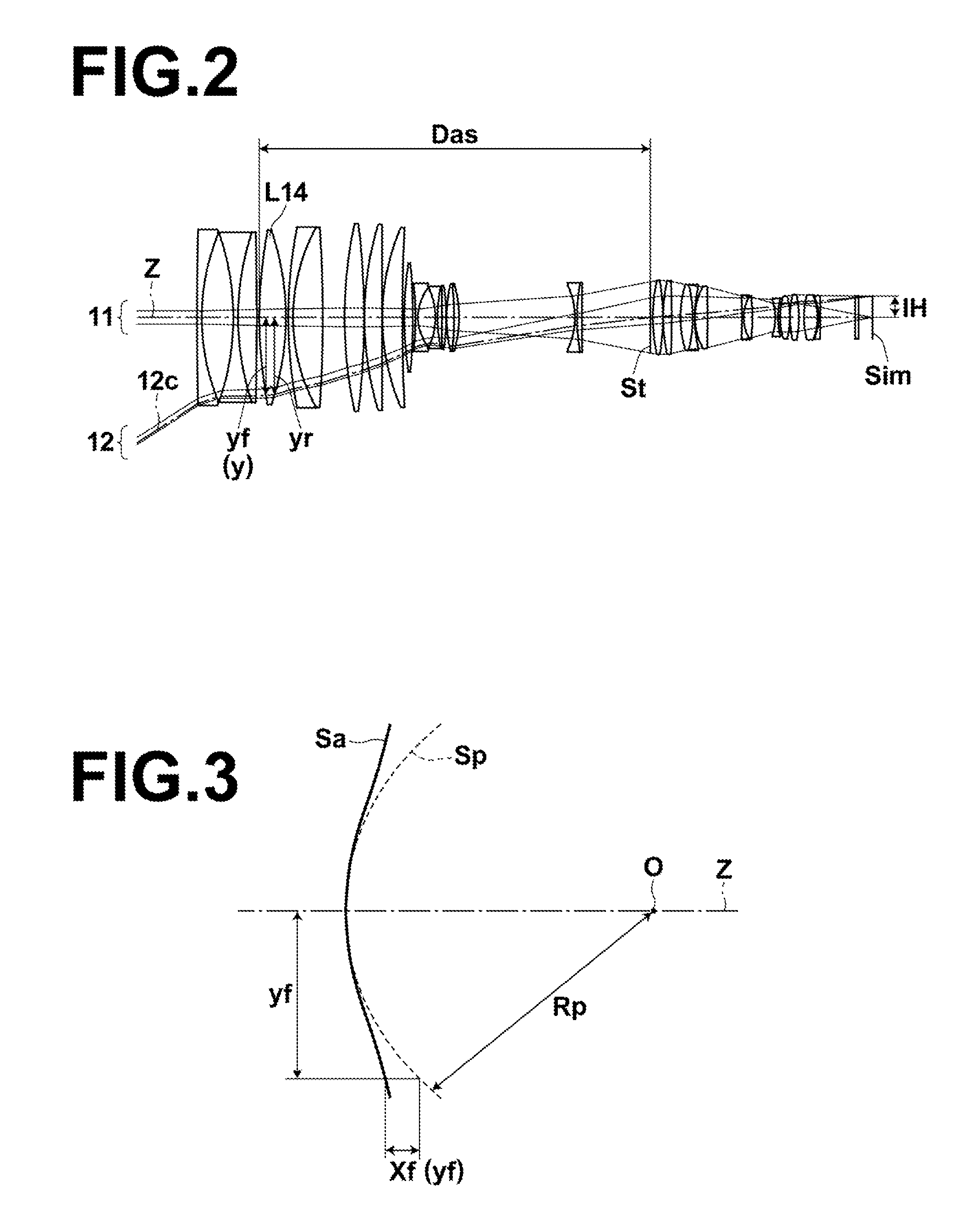Zoom lens and imaging apparatus
a zoom lens and imaging apparatus technology, applied in the field of zoom lenses and imaging apparatuses, can solve the problems of increasing the number of lenses forming increasing the size and weight of the first lens group, and achieving the effect of high optical performan
- Summary
- Abstract
- Description
- Claims
- Application Information
AI Technical Summary
Benefits of technology
Problems solved by technology
Method used
Image
Examples
example 1
[0069]FIG. 4 is a sectional view illustrating the lens configuration of a zoom lens of Example 1 when the zoom lens is focused on an object at infinity. In FIG. 4, the state at the wide-angle end is shown at the top denoted by the text “WIDE”, the state at the middle focal length is shown at the middle denoted by the text “MIDDLE”, and the state at the telephoto end is shown at the bottom denoted by the text “TELE”. On FIG. 4, the left side is the object side, and the right side is the image side.
[0070]The schematic configuration of the zoom lens of Example 1 is as follows. The zoom lens of Example 1 consists essentially of five lens groups consisting of, in order from the object side, a first lens group G1 having a positive refractive power, a second lens group G2 having a positive refractive power, a third lens group G3 having a negative refractive power, a fourth lens group G4 having a negative refractive power, an aperture stop St, and a fifth lens group G5 having a positive ref...
example 2
[0080]FIG. 5 is a sectional view illustrating the lens configuration of a zoom lens of Example 2 when the zoom lens is focused on an object at infinity. The schematic configuration of the zoom lens of Example 2 is almost similar to that of Example 1, except that, in the zoom lens of Example 2, the first lens-group middle group G1b consists of two lens groups, i.e., a first lens-group middle-group front part G1bf and a first lens-group middle-group rear part G1br, where the first lens-group middle-group front part G1bf and the first lens-group middle-group rear part G1br are moved along the optical axis direction to change an air space therebetween during focusing. The first lens-group front group G1a consists of lenses L11 to L13 in this order from the object side, the first lens-group middle-group front part G1bf consists of a lens L14, the first lens-group middle-group rear part G1br consists of lenses L15 to L16 in this order from the object side, and the first lens-group rear gr...
example 3
[0083]FIG. 6 is a sectional view illustrating the lens configuration of a zoom lens of Example 3 when the zoom lens is focused on an object at infinity. The schematic configuration of the zoom lens of Example 3 is almost similar to that of Example 1, except that, in the zoom lens of Example 3, the first lens-group middle group G1b consists of lenses L14 to L17 in this order from the object side, the first lens-group rear group G1c consists of lenses L18 to L19 in this order from the object side, and the lens L15 is the only aspheric lens included in the first lens-group middle group G1b. The object-side surface of the lens L15 is an aspheric surface, and the image-side surface of the lens L15 is a spherical surface.
[0084]Tables 7, 8, and 9 show basic lens data, specifications and variable surface distances, and aspheric coefficients of the zoom lens of Example 3. In Table 9, “-” is shown, in place of a numerical value, where no aspheric coefficient is present.
TABLE 7Example 3 - Basi...
PUM
 Login to View More
Login to View More Abstract
Description
Claims
Application Information
 Login to View More
Login to View More - R&D
- Intellectual Property
- Life Sciences
- Materials
- Tech Scout
- Unparalleled Data Quality
- Higher Quality Content
- 60% Fewer Hallucinations
Browse by: Latest US Patents, China's latest patents, Technical Efficacy Thesaurus, Application Domain, Technology Topic, Popular Technical Reports.
© 2025 PatSnap. All rights reserved.Legal|Privacy policy|Modern Slavery Act Transparency Statement|Sitemap|About US| Contact US: help@patsnap.com



